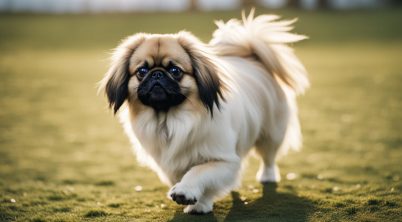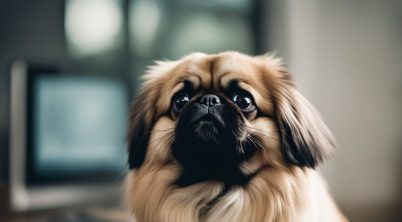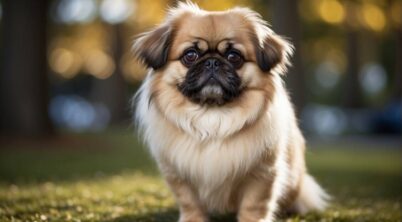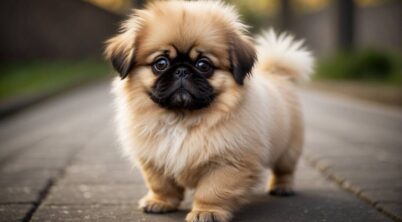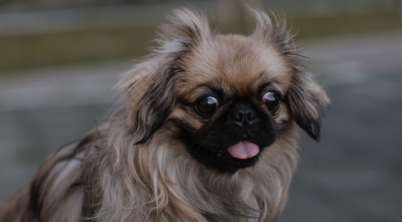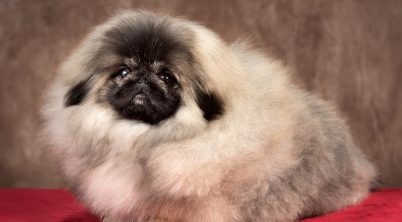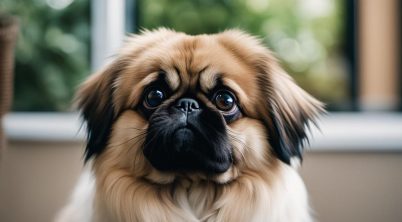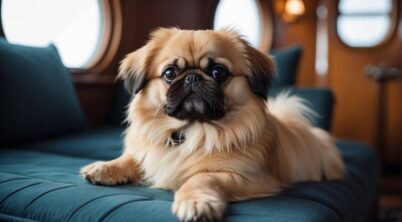The Pekingese is a dog breed that stands out for its regal bearing and luxurious double coat, which can come in a variety of colors and markings. Renowned for their history as companions to Chinese royalty, these dogs exhibit a bright and loving temperament, presenting both charm and dignity. Their thick coat requires regular grooming to maintain its splendid appearance, which draws comparisons to ornate mops because of its fullness and texture.
As a pet, the Pekingese is known for desiring attention and can be quite affectionate with family members. Their small size makes them suitable for apartment living, though their independent streak calls for an owner who appreciates their unique character and is willing to accommodate their grooming needs.
The breed’s distinctiveness particularly stands out in the show ring, where meticulously groomed Pekingese have been known to achieve high honors. The ample coat and confident personality of the Pekingese, when combined with careful grooming, result in a show-stopping presence that has earned them acclaim in dog shows around the world, including multiple Best in Show titles at prestigious events like the Westminster Kennel Club Dog Show.
Table of Contents
Pekingese Mop
The Pekingese breed, a dog known for its luxurious fur and distinctive appearance, resembles a living “mop” due to its long, flowing coat. This small breed, which hails from China, was once the cherished companion of Chinese emperors and has been associated with the image of the lion—a symbol of dignity and courage.
Physical Characteristics:
- Coat: Thickest around the neck and shoulders, resembling a mane.
- Face: Pushed-in face consistent with the breed’s brachycephalic traits.
Grooming Needs:
- Maintenance: High; regular grooming is essential to prevent tangles and mats.
- Techniques: Cording can enhance the mop-like appearance, but requires expert care.
Notable Achievements:
- Dog Shows: Pekingese have gained recognition at prestigious events.
- Malachy, a notable Pekingese, won top honors at the Westminster Kennel Club Dog Show.
Cultural Significance:
- Origin: China, where they were a symbol of royalty and nobility.
- Nickname: Often called “lion dogs” due to their mane-like coat and proud bearing.
In summary, the Pekingese is not only a beloved companion but also an embodiment of cultural history, symbolic significance, and showmanship. Despite their small size, they carry the grandeur of their imperial past and the beauty of their distinctive “mop” coats with poise and dignity.
Unique Features of Pekingese
The Pekingese breed is distinguished by its lavish double coat and a physique that reflects a big-dog demeanor in a compact form. They are further characterized by their strong bond with their owners.
Coat Characteristics
The Pekingese sports a double coat consisting of a soft, thick undercoat and a longer, coarse outer coat. This combination gives the breed its signature “lion’s mane” appearance around the neck and shoulders. While the coat is present in various colors and patterns, the maintenance of its luxurious length is a significant aspect of their care, demanding regular grooming to prevent matting.
- Coat Type: Double coated
- Long Coats: Yes
- Maintenance: High
Distinctive Weight and Bond
While small in stature, the Pekingese typically weighs between 7 to 14 pounds. Despite their modest size, they carry themselves with a dignified confidence. Their weight contributes to a surprisingly sturdy and solid frame for a toy breed. Pekingese are also known for their strong bond with their people, often forming an inseparable and loyal connection with their owners.
- Weight Range: 7 to 14 pounds
- Relationship with Owners: Deeply bonded
Dog Grooming Essentials
When grooming a Pekingese, owners must focus on managing their distinctive curls and addressing the breed’s high maintenance needs due to their thick coats.
Dealing with Pekingese Curls
Pekingese dogs are known for their beautiful, yet challenging, curly fur that requires consistent care. To effectively manage Pekingese curls, it’s essential to have a slicker brush and a metal comb on hand. A slicker brush works through the fur, gently detangling and smoothing the curls, while a comb can be used to remove any remaining snarls and ensure the coat is even.
- Brushing: Daily brushing is recommended to prevent matting.
- Products: Use a detangling spray to ease grooming and maintain fur quality.
High Maintenance Needs
Given their luxurious double coat, Pekingese dogs fall into the category of high maintenance grooming needs. Regular grooming sessions should include:
- Bathing: A gentle shampoo designed for sensitive skin to keep their coat clean without causing irritation.
- Health Checks: Each grooming session is an opportunity to check for skin issues or parasites.
Frequency:
- Brushing: Daily to prevent tangles and mats.
- Bathing: Monthly, or as needed, to keep their coat in optimal condition.
Adherence to these grooming essentials will not only maintain the Pekingese’s appearance but will also contribute to their overall health.
Comparison with Other Mop Dogs
The Pekingese, with its luxurious fur reminiscent of mop heads, is a distinctive breed within the category of mop dogs. While comparing it to other breeds in this category, certain characteristics and grooming styles set it apart.
Similar Breeds
- Komondor: Known for their white cords covering their bodies, the Komondor is the epitome of a mop dog. Unlike the Pekingese, which has a long, straight coat, the Komondor’s coat forms natural tangles that resemble the strands of a mop.
- Puli: The Puli shares the corded coat characteristic with the Komondor, but it tends to be smaller in size. Its dreadlock-like coat can often make it look quite similar to the larger Komondor at first glance.
- Bergamasco Sheepdog: This breed has a unique felted coat that takes on a mop-like appearance as it matures. Compared to the Pekingese, a Bergamasco’s coat is more distinctly matted.
- Havanese: Although not typically considered a classic mop dog, the Havanese has a long, flowing coat that requires extensive grooming. Their fur can give mop-like visuals when grown out and not regularly maintained.
Dogs with Dreads
- Spanish Water Dog: This breed’s curly and wooly coat has the tendency to form tight cords if left unclipped. Unlike the Pekingese, which has a flowy coat, the Spanish Water Dog’s coat can take on a more rounded and dreadlock-like appearance.
- Puli and Komondor: As the most iconic dogs with dreads, their corded coats are a result of the natural matting and felting of hair over time. These cords require a different grooming methodology than the straight-haired Pekingese to prevent matting.
By understanding these differences and similarities, it’s evident that the category of mop dogs encompasses a variety of breeds with unique grooming needs and visual appeal. Each breed carries a distinctive charm, with the Pekingese offering a straight-coated alternative to the corded and curly-haired varieties.
Training and Dog Shows
Training a Pekingese for dog shows requires dedication and an understanding of the breed’s distinctive characteristics. Handlers aim to accentuate their lionlike appearance and noble demeanor.
Preparing for Competitions
A Pekingese’s training for shows is comprehensive, focusing on both physical and behavioral aspects. They must learn to respond to their handler’s commands gracefully and maintain composure in the bustling environment of a dog show. The training process includes:
- Socialization to adapt to large crowds and unfamiliar dogs
- Gait training to develop the Pekingese’s characteristic dignified trot
- Stance practice to showcase their well-balanced and compact structure
Consistency in training sessions helps the Pekingese develop the necessary skills and temperament to compete successfully.
Significant Achievements
The Pekingese breed has a history of success in dog shows, with notable highlights including:
- Best in Show at the Westminster Dog Show: The Westminster Kennel Club Dog Show is one of the most prestigious events in the canine competition world. A Pekingese named Wasabi won Best in Show in 2021, showcasing the breed’s potential in the ring.
- Breed Representation: Pekingese are regular contenders at various canine competitions, often praised for their appearance and composure. Handlers play a crucial role in presenting the dogs effectively, emphasizing their lionlike mane and balanced proportions.
Pekingese Lifestyle Considerations
The Pekingese dog breed adapts well to various living situations but has some specific lifestyle considerations for potential owners to bear in mind. These considerations can affect how a Pekingese might fit into someone’s daily life and home environment.
Apartment Living
Pekingese dogs are generally well-suited for apartment living due to their size and indoor activity level. They do not require vast amounts of space to roam and are content with shorter, regular walks. However, they do have a thick coat that requires regular grooming to manage shedding.
- Indoor Space Requirements: Minimal; thrives in cozy settings
- Exercise Needs: Moderate; short daily walks and play sessions
Bonding with Owners
They tend to form a strong bond with their owners, becoming devoted and affectionate companions. Pekingese require attention and do not like being left alone for long periods. They appreciate consistent interaction, which reinforces the bond between dog and owner.
- Companionship: Highly valued by the breed
- Attention Needs: High; prefers frequent interaction
Role as Guard Dogs
Despite their small stature, Pekingese can be quite territorial and may bark to alert their owners of strangers, thus acting as guard dogs in their own way. They are naturally wary of unfamiliar people, which can manifest as guarding behavior. Proper socialization from a young age can help them become more discerning in their reactions.
- Alertness: High; will bark at perceived threats
- Protection Instinct: Moderate; protective but not aggressive
Health and Wellbeing of Pekingese
The Pekingese breed, known for its long history as companion dogs, faces certain breed-specific health challenges. Recognizing and addressing these issues early on can contribute to a healthier life for these dogs.
Health Challenges
Pekingese are prone to a variety of health issues, many of which relate to their distinctive physical characteristics. They have a flat face (brachycephalic), which can lead to breathing difficulties and overheating. Owners should watch for signs of respiratory distress, especially during hot weather or exercise.
Being a small breed, Pekingese may also suffer from joint issues like patellar luxation, where the kneecap dislocates, causing pain and potential mobility issues. Regular veterinary check-ups can help in early diagnosis and treatment.
This breed can face eye conditions due to their large, prominent eyes. Dry eye, corneal ulcers, and entropion are some of the common eye problems Pekingese may encounter. Eye care should include regular cleaning and prompt veterinary attention if signs of eye issues appear.
Their long coat needs regular grooming to prevent matting and skin infections; it’s not only a matter of beauty but also health. Diet plays a crucial role, and Pekingese should be given a balanced diet to avoid obesity, which can exacerbate other health issues.
Dental health is another concern for Pekingese dogs. They are susceptible to periodontal disease, and therefore, a dental care routine including regular brushing and dental check-ups is vital to their wellbeing.
Regular exercise tailored to their capabilities can help maintain a healthy weight and joint health. As with all breeds, they benefit from a loving, stress-free environment which contributes to their overall well-being.
Cultural and Historical Significance
The Pekingese breed is inextricably linked with the history of China, reflecting its past emperors’ splendor and the cultural significance of the lion within Buddhism.
The Imperial Status
Historically, the Pekingese dog was the most revered companion in the Chinese Imperial Court, an exclusive privilege of the emperor and his family. These dogs were often referred to as “lion dogs” because of their resemblance to Chinese guardian lions. This association was deeply symbolic, representing power and protection, which made the Pekingese highly valued by Chinese nobility.
The lion, regarded as a sacred creature in Buddhist tradition, was believed to bring peace and serenity. By virtue of their likeness to lions, the Pekingese, therefore, became a living symbol of these virtues. The breed was so closely guarded within the royal palace that commoners were forbidden to own them, ensuring they remained a status symbol exclusive to the imperial household.
These dogs were not merely pets; they were a testament to imperial dignity and divine favor. Emperors are often portrayed with their loyal Pekingese companions, suggesting a deep bond and a high degree of reverence for these small yet significant members of the court. Being bred and cherished within the confines of the Forbidden City, they have been a part of China’s cultural tapestry for over two millennia, their existence shaped by and shaping the lives of those in power.

